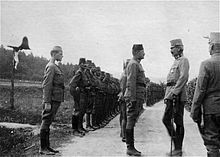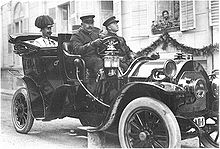Eugene of Austria-Teschen

Archduke Eugen Ferdinand Pius Bernhard Felix Maria of Austria (born May 21, 1863 in Groß Seelowitz , Moravia ; † December 30, 1954 in Meran , South Tyrol ) was Field Marshal of the Austro-Hungarian Army and the last secular Grand Master of the Teutonic Order (1894–1923), at the same time the last from the House of Habsburg to date .
Life
Archduke Eugen was born in 1863 as the youngest son of Karl Ferdinand (1818–1874), a son of Archduke Karl von Österreich-Teschen . His mother was Archduchess Elisabeth Franziska Maria (1831–1903), daughter of Joseph Anton Johann of Austria , the Palatine of Hungary. Among his older brothers were the Austro-Hungarian Field Marshal Friedrich (1856–1936) and Admiral Karl Stephan (1860–1933). Both his father and mother were grandsons of Emperor Leopold II , who is or was Eugen's great-grandfather twice.
Like all members of the Habsburg family, he also learned a trade as a “civil” profession, in his case a carpenter.
In 1898 he acquired the Hohenwerfen Fortress in Salzburg and had it expanded into his princely seat. His large art and weapons collection was also located there. When the fortress burned down to a large extent through carelessness in 1931, he financed its reconstruction. In 1938 he had to sell the property to the National Socialist district administration.
Archduke Eugen succeeded his uncle Archduke Wilhelm in 1894 as the last secular Grand Master of the Teutonic Order. Under his leadership this was transformed into a purely spiritual order. As head of the Teutonic Order, he was also the owner of the famous infantry regiment "Hoch- und Deutschmeister" No. 4 from 1894 . On January 11, 1897, he was invested in Igls near Innsbruck as Grand Officer of the Order of the Knights of the Holy Sepulcher in Jerusalem in the Austrian Lieutenancy and was lastly Knight of the Grand Cross.

After the World War he left Austria in April 1919 and went into exile in Basel until 1934 . In 1934 he first moved from Switzerland to the Teutonic Order Castle in Gumpoldskirchen . However, under pressure from the National Socialists, he had to move to Vienna. After the Second World War he lived in Igls near Innsbruck. He died after surviving pneumonia during a cure in Merano on December 30, 1954. According to his request, he was buried in Innsbruck Cathedral ( St. Jakob Cathedral ).
Military career
Like two of his older brothers, Eugene embarked on a career in the military. At the age of 14 he joined the Imperial and Royal Army of the Tyrolean Kaiserjäger , on October 27, 1877, he became a lieutenant and on May 1, 1881, a first lieutenant . From 1883 to 1885 he graduated from the Theresian Military Academy in Wiener Neustadt and was trained as a general staff officer. On November 1, 1885 he was promoted to captain and on February 23, 1887 to Rittmeister . Between 1887 and 1888 he served in Hussar Regiment No. 5 and on October 26, 1888 he was promoted to major. On October 27, 1889, he was appointed lieutenant colonel and commander of the 100th Infantry Regiment. On April 26, 1890 he became a colonel and took over the Hussar Regiment No. 15 the following year. On October 28, 1893 he was promoted to major general and took over the 9th Infantry Brigade in Olomouc . On April 26, 1896 he reached the rank of Lieutenant Field Marshal and was given command of the 25th Infantry Division. On April 27, 1901, he was promoted to General of the Cavalry and from 1900 to 1908 Commanding General of the XIV Army Corps in Innsbruck.

During the First World War , Eugen took over command of the Balkan forces in December 1914 as the successor to Oskar Potiorek . Together with his chief of staff Alfred Krauss, he reorganized the 5th Army , which was badly battered in the campaign against Serbia , which was relocated to the new Isonzo front as a result of Italy's declaration of war in May 1915 . Archduke Eugen was promoted to Colonel General on May 22, 1915 and took command of the Austrian Southwest Front against Italy on May 27 . At first he headed the defense on the Isonzo , but moved his headquarters to Bolzano the following year . During the South Tyrol offensive in May and June 1916, the Austro-Hungarian 11th Army under Viktor Dankl and the 3rd Army under Hermann Kövess were subordinate to him.
Archduke Eugen was appointed Field Marshal on November 23, 1916, together with Franz Conrad von Hötzendorf . Despite the success of the 14th Army in the Twelfth Battle of the Isonzo , he was relieved of his position as commander of the Austrian South-Western Front against the will of the new Chief of the General Staff , Colonel General Arz von Straussenburg , on December 18, 1917, and retired from active service on January 11, 1918 adopted.
Honors
The Archduke was the owner of the Imperial and Royal Infantry Regiment Hoch- und Deutschmeister No. 4 , the Imperial and Royal Infantry Regiment "Archduke Eugen" No. 41 and chief of the Cuirassier Regiment "Graf Wrangel" (East Prussian) No. 3 .
Eugen was also the holder of the highest order:
- Order of the Golden Fleece
- Star and cross of the Grand Commander of the Royal House Order of Hohenzollern with swords on August 4, 1915
- Grand Cross of the Military Max Joseph Order on November 16, 1915
-
Pour le Mérite with oak leaves
- Pour le Mérite on May 23, 1916
- Oak leaves on November 3, 1917
- Grand Cross of the Military Maria Theresa Order on July 15, 1917
In his honor, a memorial designed by Clemens Holzmeister and Hans Andre was erected in the Kleiner Hofgarten in Innsbruck in 1957 . In addition, the Erzherzog-Eugen-Strasse in the Saggen district was named after him.
Trivia

Since Archduke Eugen was one of the first noble motor vehicle owners, he received the first official motor vehicle registration number that was issued in Austria-Hungary , namely A 1 . He bought the car, a Hispano-Suiza , in Geneva . He hired the mechanic Gottlieb Wiederkehr as a chauffeur. On January 30th, 1906, Wiederkehr received driving license no.1 in Innsbruck.
The Villa Eugen is named after him.
literature
- Nikolaus von Preradovich : Eugene. In: New German Biography (NDB). Volume 4, Duncker & Humblot, Berlin 1959, ISBN 3-428-00185-0 , p. 673 ( digitized version ).
- Archduke Eugen von Habsburg , in: Internationales Biographisches Archiv 08/1955 from February 14, 1955, in the Munzinger archive ( beginning of article freely available)
Web links
- Works about Eugen von Österreich-Teschen in the German Digital Library
- Entry on Eugen von Österreich-Teschen in the Austria Forum (in the AEIOU Austria Lexicon )
- Biography at Austrian Commanders
- Sound recording of Archduke Eugen in the archive of the Austrian Media Library
Individual evidence
- ^ Eugen Ferdinand Pius Bernhard Felix Maria Habsburg-Lothringen (1863-1954) | WikiTree FREE Family Tree. Retrieved April 19, 2019 .
- ^ "The history of the Austrian Lieutenancy - Festschrift 2004" , Order of Knights of the Holy Sepulcher in Jerusalem , accessed on March 6, 2017.
- ↑ Wolfgang R. v. Wurzbach-Tannenberg: Catalog of my collection of medals, plaques and tokens . Unchanged reprint of the first edition published in 1943. No. 1972. Peter Siemer, Hamburg 1978, ISBN 3-921683-11-4 .
- ^ The grave of Eugene of Austria-Teschen. knerger.de
- ↑ Wiesauer: Monument to Field Marshal Archduke Eugen. In: Tyrolean art register . Retrieved January 13, 2020 .
- ↑ Josefine Justic: Innsbruckerstraße name. Where do they come from and what they mean . Tyrolia-Verlag, Innsbruck 2012, ISBN 978-3-7022-3213-9 , p. 61-62 .
| personal data | |
|---|---|
| SURNAME | Eugene of Austria-Teschen |
| ALTERNATIVE NAMES | Eugene of Austria; Habsburg, Eugen von |
| BRIEF DESCRIPTION | Austrian Field Marshal in World War I, Grand Master of the Teutonic Order, Archduke of Austria |
| DATE OF BIRTH | May 21, 1863 |
| PLACE OF BIRTH | Groß Seelowitz , Moravia |
| DATE OF DEATH | December 30, 1954 |
| Place of death | Meran , South Tyrol |



